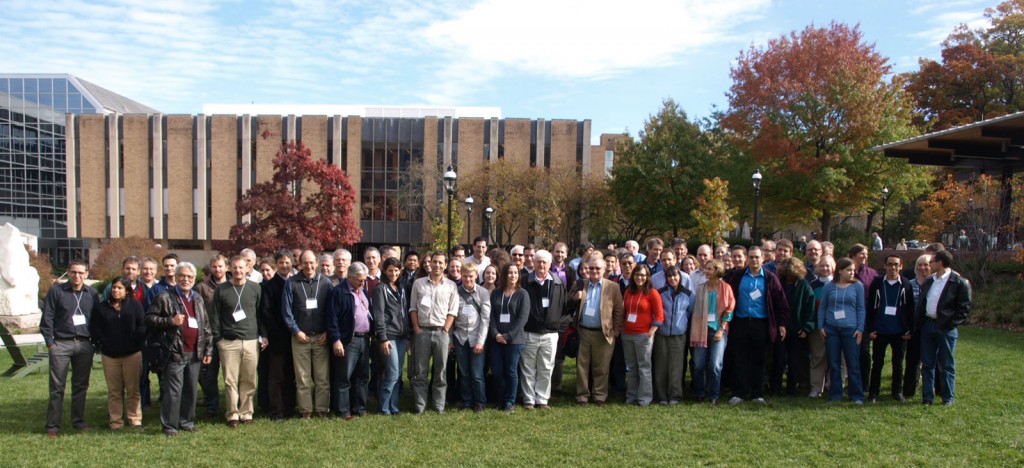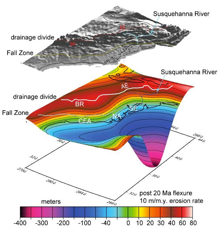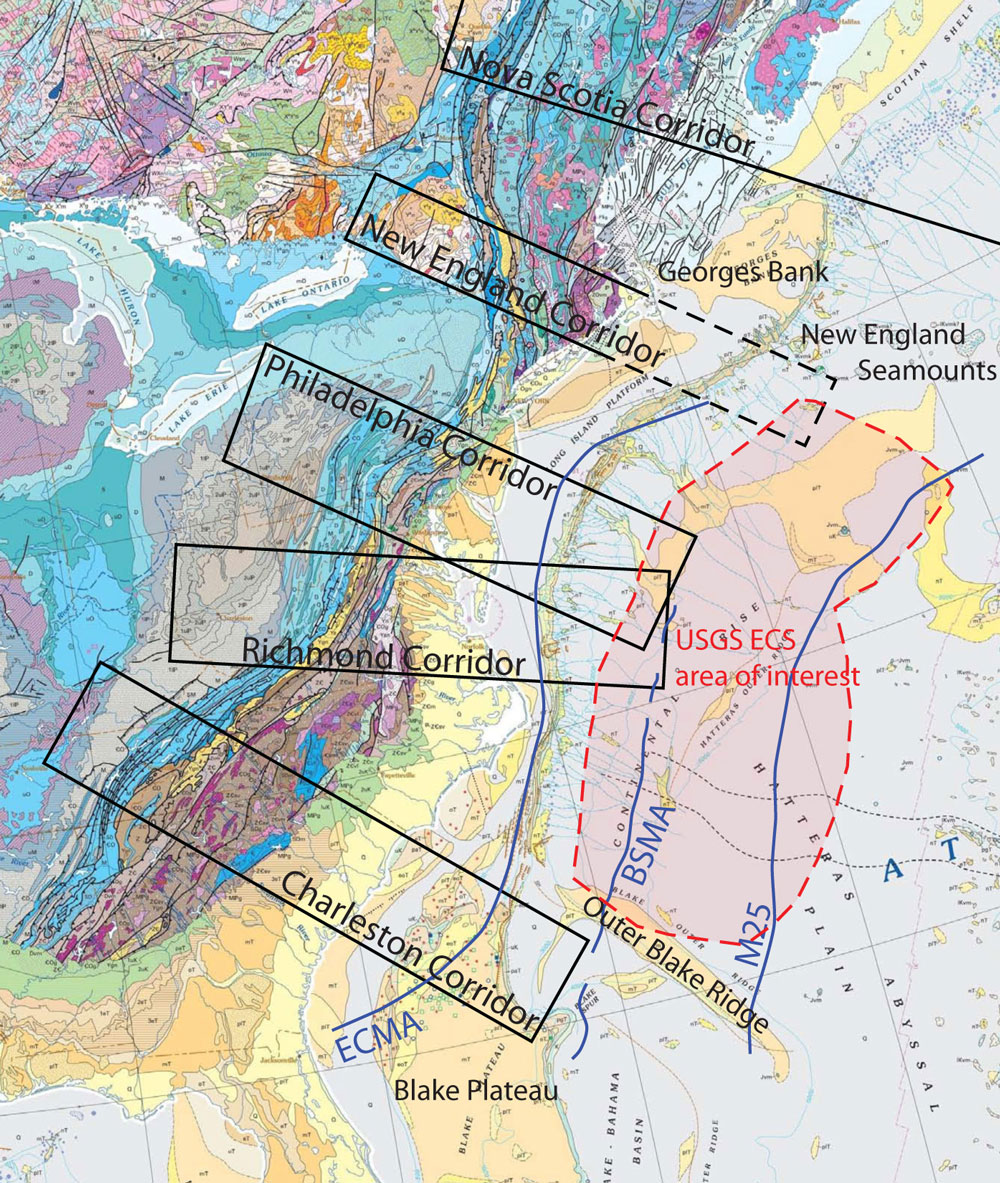Sunday December 10, 2017, 8:30 AM – 1:00 PM
Conveners: Colton Lynner and Zach Eilon
08:30 | Welcome and Introductions – GeoPRISMS Chair Demian Saffer and Colton Lynner
Appalachian Mountains
08:45 Keynote | The Appalachians – Lara Wagner
09:05 – 09:25 | Pop-ups by early career participants
Characterizing the Southeastern Appalachian Margin via integrated potential field and structural modeling– Patrick Duff
Insights on magmatic addition beneath the Atlantic Coastal Plain from crustal refraction seismic data – Lindsay Worthington
Localized rifting and magmatism from the crustal velocity structure of the Southeastern United States – Rachel Marzen
09:30 Keynote | Surprising magnetotelluric results from the Eastern North American Margin – Ben Murphy
09:50 | Discussion
10:25 | Break
Offshore Margin
10:40 Keynote | Offshore ENAM margin Final stages of continental breakup and early seafloor spreading history – Anne Bécel
11:00 – 11:20 | Pop-ups by early career participants
Offshore Margin – Brandon Shuck
Refining the formation and early evolution of the Eastern North American Margin – John Greene
How fast were the ECMA SDRs emplaced? – Joshua “Bud” Davis
Expanded mid-Atlantic deep water allostratigraphy – James Gibson
11:20 | Discussion
Margin-wide Synthesis
11:50 Keynote | Margin-wide synthesis – Roger Buck
12:10 – 12:20 | Pop-ups by early career participants
Explore the Uplifting Mechanism of the Adirondack Mountains – Xiaotao Yang
Lithospheric structure of the Southeastern US – Erin Cunningham
12:20 | Discussion
12:45 | Conclusion – Zach Eilon
The Eastern North American Margin (ENAM) GeoPRISMS focus site is a type locale for the terminal stage in the evolution of a passive rift margin. New observations, as well as reevaluations of legacy datasets, hold promise for improving our understanding of the evolution, history, and present-day topography of the Appalachian Mountains, anomalous volcanism along the margin, crustal and lithospheric structures as determined through multiple data types, the transition from ocean to continent and possible diachronous breakup, and dynamic processes in the mantle. The particular strength of the GeoPRISMS community lies in its combination of expertise in diverse fields (e.g. seismology, magnetotellurics, geology, structure and surface processes, geochemistry, and dynamical modeling) to address large outstanding problems. A crucial aspect to this community approach is the maintenance of periodic synthesis meetings that provide a multidisciplinary forum for comparison and integration of novel research findings. This mini-workshop will be held at the Westin Canal Place (http://www.westinneworleanscanalplace.com) on Sunday, December 10th, prior to the Fall 2017 AGU meeting, and will focus on new results from investigations of the ENAM at a variety of scales, with a focus on research highlights and outstanding research questions that demand integration of multiple perspectives. We have prioritized early-career (grad student + post-doc) contributions and ample discussion time to emphasise a forward-looking approach to this community endeavour.
Sunday December 10, 2017 | AGU Fall Meeting 2017 | New Orleans, LA
Organizers: Zachary Eilon1 and Colton Lynner2
1UC Santa Barbara, 2U Arizona
The Eastern North American Margin (ENAM) science advances: progress and outlook mini-workshop was held on Sunday morning immediately preceding the 2017 AGU Fall Conference. This workshop was designed to provide an opportunity for community presentation and discussion of new and future work on the Eastern North American Margin. The timing of the workshop, approximately two years following the conclusion of the ENAM Community Seismic Experiment (CSE), was ideal for showcasing mature research projects that span the entirety of the margin, from the Appalachian Mountains to the offshore region. The workshop featured products of the amphibious broadband seismic and multi-channel seismic (MCS) data as well as the integration of EarthScope Transportable Array with the ENAM-CSE.
This workshop had 34 participants in total, including 20 (59%) early-career scientists (graduate students and post-docs) – this attendance despite weather related travel difficulties for many attendees. In order to promote the integration of multiple scientific perspectives and sub-disciplines that encompass the ENAM, the mini-workshop was organized thematically by geographic region. Sessions were divided between the Appalachian Mountains and the Onshore Margin, the Offshore Margin, and Margin-Wide Synthesis, ordered sequentially for a geographic and thematic progression. The format of the workshop was split approximately evenly between keynote presentations (20 minutes each), pop-up talks (5 minutes each) and discussion time. Keynote speakers were asked to give an overview of the active research topics and outstanding questions in each region. Pop-up talks were selected from graduate-students and early career researchers who applied to speak at the mini-workshop. This format allowed 15 separate presenters to highlight their recent research products, while also building in opportunities for participants to talk through consistencies and incongruences between cutting-edge results.
Here, we summarize the main conclusions of the presentations and discussions (for speaker affiliations, see workshop schedule, below):
Appalachians and Onshore Margin:
Lara Wagner provided a thorough tectonic and literature background for ENAM research; she emphasized that for a “passive” margin, ENAM looks surprisingly active, with ongoing seismicity, Eocene volcanics near Harrisonburg, and steep relief. Lara noted that variations in the Appalachian orogen along-strike may reflect pre-existing Grenville structure underlying the present margin. Her surface wave models reveal a localized low-velocity upper mantle anomaly precisely co-incident with the Eocene volcanics, posited as a lithospheric hole/drip. In addition, she images a slow anomaly resembling delamination beneath the Cape Fear Arch and distinct lithospheric structure across the Grenville front that indicates significant lithosphere-asthenosphere (LAB) boundary topography well inboard of the ocean-continent transition.
Patrick Duff used magnetic and gravity modeling along with legacy seismic datasets to argue for ~370km of shortening during Appalachian orogenies. He showed that lower-crustal variability was not necessarily needed in order to account for the gravity signal. His results suggest that the Carolina Terrane does not extend the entire depth of the crust and that the Grenville basement extends farther east than previously thought.
Lindsay Worthington showed new results from the on-land component of the ENAM-CSE active source experiment. Her results show a surprisingly simple lower-crustal structure beneath the onshore portion of the margin, with elevated supra-Moho velocities perhaps indicating crustal underplating related to the initial formation of the ENAM on one of the two lines. High crustal velocities seem to be only present on the southern line, suggesting high variability in crustal structure and underplating.
Rachel Marzen’s work on the SUGAR lines (South Georgia Basin) crosses Mesozoic rift basins and multiple potential suture zones between accreted terranes. They observed high Vp and Vs within the Inner Piedmont and Carolina accreted terranes that are underlain by a low velocity zone at ~5 km depth. Differences in the basin structure, lower crustal velocities, and crustal thickness between the two lines reflect varying extension and magmatism despite their extremely close proximity.
Cong Li’s P-s receiver function study (ably presented in his absence by Xiaotao Yang) indicates good correlation between Bouger gravity and Moho topography in New England, suggesting that Mesozoic terrane boundaries still control today’s Moho gradients with significant offsets in Moho topography associated with the northern Appalachians.
Ben Murphy presented magneto-telluric (MT) evidence for a deep, electrically-resistive body beneath the piedmont, spanning the region from Georgia to Virginia and extending from just east of the mountain belt to the coastline. He argued, based on extensive sensitivity testing, that this feature must be deep (up to 300 km) and so strongly resistive that it must be dry and colder than ~1200˚C; this MT signature is comparable to that of a craton. Ben also sees conductors beneath the Appalachians, and arguably beneath the Harrisburg anomaly.
Much of the discussion for this session focused on the discrepant tomographic and MT results beneath the coastal plain. Whereas tomographic images clearly delineate a thin piedmont seismic lithosphere (in contrast to thicker lithosphere inboard of the Grenville front), the MT data indicates almost the exact opposite, with thick resistors outboard of the orogen. There was also significant discussion regarding the differences between lower crustal active source lines (both on a small scale, such as the differences between the two ENAM-CSE onshore active source lines, and on a margin-wide scale, such as differences in Moho topography or variability between terranes and rifting contexts). There appear to be variation in the factors controlling Moho topography, crustal underplating, and lower-crustal structure both along strike and orthogonal to the passive margin.
This was the first of a series of discussions related to the theme of lateral heterogeneity and observational discrepancies along the ENAM. The discrepancy between MT and seismic tomographic results, along with our understanding of lithospheric structure in a passive margin, suggests there is something chemically or thermally unique about the onshore portion of the margin. We discussed a variety of mechanisms, including hydration state, thermal anomalies, seismic anisotropy, magmatic underplating, etc., that could account for both the thin seismically-inferred lithosphere and the thick lithosphere indicated by MT data. The group’s consensus was that more work is needed to settle the debate. In a similar vein, the lateral crustal heterogeneities indicated by receiver-function, active source, and modeling data require highly variable structural controls in order to account for the difference in observations over short lateral scales, and these may provide insight into a spectrum of mechanisms involved in margin formation along strike. We concluded this section (as with the entire workshop) with the questions: 1) Is there such a thing as a type locale for a magmatic (or really any type) of passive margin? 2) What is the necessary scale of an experiment to capture all of the complexities and variability of a passive margin? 3) What does the lithosphere-asthenosphere boundary look like across the ENAM?
Offshore Margin:
Anne Becel presented high quality MCS and wide-angle refraction results spanning the entire continental margin. Among the notable features were a continuously map-able Moho, erosional unconformities demarcating rift-related sedimentation, well-captured seaward-dipping reflectors (SDRs) and thick ocean-continent transitional crust in the region of the East Coast Magnetic Anomaly (EMCA). Modelling indicates that the ECMA is produced by a 10-15 km thick packet of SDRs with high magnetic susceptibility. Anne argued that rough basement topography in transitional crust, including 10-20 km tilted blocks, is an indication that early seafloor spreading was very slow. She shows that the Blake Spur Magnetic Anomaly (BSMA) coincides with thickening extrusive basalts and high-velocity lower crust, both attributable to hotter potential temperatures (Tp) at the time of formation.
Brandon Shuck’s OBS results were in strong agreement with Anne’s findings. He used petrological modelling to argue that thickened Blake Spur Magnetic Anomaly (BSMA) crust implies Tp ~ 1450˚C, positing that heterogeneity in source mantle fertility could explain along-strike crustal thickness variations. Noting that the BSMA has no African margin counterpart, Brandon suggested that this feature represents a melt pulse upon final lithospheric breakup.
John Green presented refined magnetic anomaly correlations throughout the offshore ENAM and assigned updated ages and chron numbers to M0-M25 and eight pre-M25 anomalies, identifying five correlated magnetic anomalies between the East Coast Magnetic Anomaly (ECMA) and the BSMA. His results suggest that, if the BSMA source is oceanic crust, the BSMA may have formed ~168.5 Ma and represent the initiation of oceanic crust formation. His results also suggest asymmetric crustal accretion indicating possible ridge re-orientation early in Atlantic opening, potentially involving a ridge jump.
Joshua Davis presented his modelling of ECMA SDR emplacement, seeking to explain the paradoxical observations that this feature is a single (positive) magnetic anomaly – implying extraordinary SDR emplacement rates – with no negative analogue. He argued that this feature was not produced within the span of a single magnetic reversal, but is in fact an induced anomaly (explaining the absence of similar negative anomalies) that may have formed slowly (5-20 My).
James Gibson expanded deep water allostratigraphy observations to show that bottom-current erosion rates vary along the margin. Fast erosion and large slope failures in the south contrast with well-developed fan structures to the north; deep currents may have controlled transport of slope sediments to the deep sea.
At the conclusion of the Offshore Margin session, discussions focused primarily on the location of initiation of oceanic crustal formation and on the best ways to assimilate offshore results with onshore data. Previous published studies have suggested the ECMA as the location of initial formation of oceanic material, but several pop-up talks presented results that indicate the BSMA is the site of initial crustal formation. BMSA rifting initiation seems to be a fairly robust result, coming from both seismic and magnetic data. This new conclusion alters the estimates of the extent of thinning and spreading of continental material along the margin. There may be far more highly attenuated continental material along that ENAM than previously thought. Merging offshore structural inferences to those made onshore remains a challenge facing the ENAM community, as applying uniform processing techniques to both datasets has yet to be widely achieved. Both regions show laterally variable structures and Moho topography. Connecting the site of rift initiation (either the ECMA or BSMA) to the inferred magmatic underplating and sea-ward dipping reflectors seen in both the offshore and onshore active-source data also remains an area of focus for the ENAM community. Placing the magmatic features of the margin in the context of oceanic crustal formation and highly attenuated continental crust represents an unprecedented opportunity to advance our understanding of intrusive structures in rifted margins, and may provide a tool with which to address the level of lateral variability in crustal structure across the ENAM.
Margin Overview:
Roger Buck gave an expansive overview of the large outstanding geodynamic questions in the context of rifts: Are plumes important for rift initiation? What role does pre-existing structure play? Roger discussed the rarity of a rift directly abutting a large orogenic province such as the Appalachians, and discussed implications of this juxtaposition. He focused on the chicken-egg problem of melting and rifting, as well as the possibility of using SDRs as a proxy for paleo-elastic thickness. He raised the possibility that Newark-series basins (which pre-date CAMP) represent a failed rift, emphasizing that with time, failed rifts can become stronger than the plate around them.
Xiaotao Yang showed results of his full-waveform ambient noise Vs tomography in the Adirondacks, where accreted terranes inboard of the Appalachian orogen are co-located with a Bouger gravity high. He showed localized low VS in the upper mantle in this region; when modeled, the associated density structure explains the high topography, perhaps related to edge-driven convection.
Erin Cunningham’s S-p and P-s receiver function common conversion point maps reveal crustal thickening beneath the eastern Tennessee seismic zone, after she has processed the data using a novel sediment removal filter technique.
The conclusion of the Margin Overview session served as both a discussion on the overall structures and processes associated with the ENAM and on mature passive margin formation worldwide. As one of the GeoPRISMS primary sites, inferences made at ENAM should be applied more broadly to advance our understanding of rifting processes. This lead to significant discussion as to whether such applications are justified, given all of the variability and discordant results observed along the margin. Even the most basic questions, such as: What is the Moho topography? What is the LAB structure? Where did rifting begin? Is there magmatic underplating beneath the margin? seem to have answers that strongly depend on the specific seismic lines, imaging techniques, and geophysical observables being used. Our final conclusion was that we have learned that ENAM is more complex and recently active than was previously appreciated, and that there may be no such a thing as a ‘type-locale’ for a passive margin. The ENAM community has a lot more discovery and discussion lying ahead as we reconcile the different observations and begin to unravel the controls on the variable nature of the margin.



 Description
Description